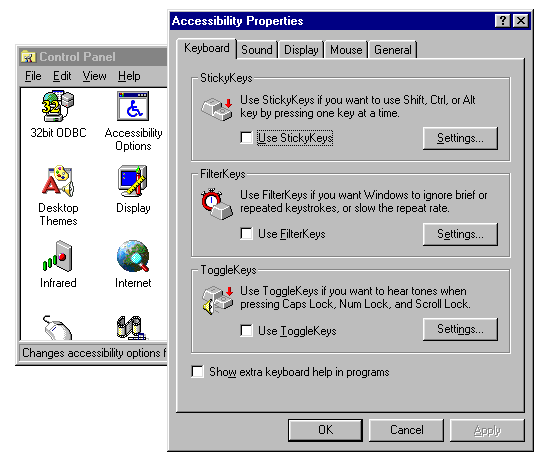[ The PC Guide | Systems and Components Reference Guide | Keyboards | Keyboard Software Issues ]
Accessibility Features (StickyKeys, FilterKeys and ToggleKeys)
Modern versions of Windows provide a number of accessibility features that are designed to make the system easier to use for those with special needs. Several of these are related to the operation of the keyboard. All of these function at the operating system level and so work transparently to virtually all software.
To set accessibility features related to the keyboard, open "Accessibility Options" (indicated by the wheelchair icon) within the Control Panel. The first (default) screen is the Keyboard tab. It contains controls for the following nifty features:
- StickyKeys: This feature changes the way that modifier keys work. Normally, keys like <Shift>, <Ctrl> and <Alt> are only "active" while they are held down; when you release them the system forgets they were ever pressed. This causes problems for some users who can't, for example, hold down three keys at once to enter a combination like <Ctrl>+<Shift>+<F3>. When enabled, this function causes modifier keys to "stick" until they are either manually released, or until a keystroke combination is complete. (In other words, it makes "temporary" modifier keys behave more like "permanent" or locking ones.) There are a number of settings to allow options like confirmation sounds, to automatically turn it off when no longer needed, and so on.
- FilterKeys: This feature can be considered the opposite of the Typematic feature; it causes Windows to suppress or ignore bursts of keystrokes that are sent too quickly--either fast streams of the same key or clumps of different keys sent all at once. Such bursts might, for example, be made by someone who does not have perfect control of his or her fingers due to a tremor. A number of settings let you control how long a key must be held down for it to register, set audible confirmations and other options.
- ToggleKeys: This feature causes Windows to provide an audible indication when any of the permanent (locking) modifier keys is pressed. In essence, this is like an audible version of the indicator LEDs on the keyboard.
|
The Windows "Accessibility Options" dialog
box, set to the "Keyboard" tab. |
All of these functions can be enabled without a trip to the Control Panel, if you know the appropriate short-cut command (shown within the relevant Accessibility options settings screens.)
![]() Warning: Be sure you do not
accidentally enable any of these features if you are not going to use them. (I was
surprised to discover that I have a habit of tapping on the <Shift> key sometimes
when I am thinking; five presses of the <Shift> key in a row is the sequence to turn
on StickyKeys... talk about a surprise. :^) )
Warning: Be sure you do not
accidentally enable any of these features if you are not going to use them. (I was
surprised to discover that I have a habit of tapping on the <Shift> key sometimes
when I am thinking; five presses of the <Shift> key in a row is the sequence to turn
on StickyKeys... talk about a surprise. :^) )
![]() Next: BIOS
Settings
Next: BIOS
Settings
| The PC Guide
(http://www.PCGuide.com) Site Version: 2.2.0 - Version Date: April 17, 2001 © Copyright 1997-2004 Charles M. Kozierok. All Rights Reserved. |
Not responsible for any loss resulting from the use of this site. Please read the Site Guide before using this material. |
